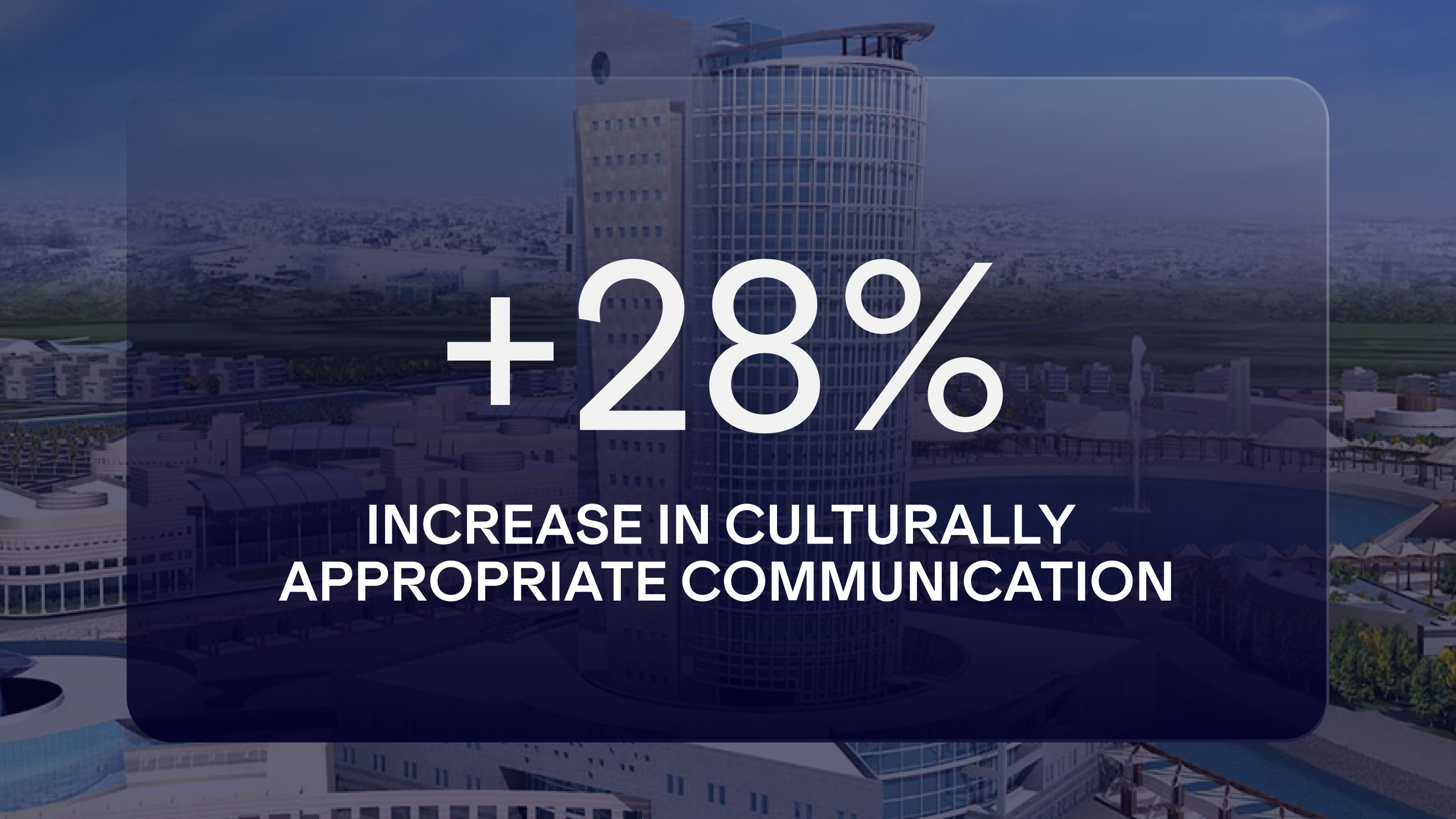IMMERSE Insights:
- IMMERSE helps English as a Foreign Language (EFL) learners develop culturally appropriate communication skills, addressing a crucial gap often missed by traditional grammar-focused programs.
- Students experienced a 28% improvement in their ability to use English appropriately in real-world situations, while also gaining confidence and awareness of cultural nuances in language use.
- The platform provides a safe, immersive, and realistic environment for practice, significantly increasing learner confidence and comfort in expressing themselves without the fear of judgment.
Partner Background
Many English as a Foreign Language (EFL) programs in Saudi Arabia focus heavily on grammar and vocabulary, with little emphasis on the social use of language, known as pragmatic competence. To address this gap, I designed a six-week online project-based intervention using IMMERSE to help Saudi female learners develop pragmatic competence in English.
This project aimed to:
- raise learners’ awareness of how cultural and contextual factors (such as power, distance, and social norms) influence language use in academic interactions with professors and classmates.
- engage learners in various collaborative tasks where they were encouraged to notice, analyze, and produce pragmatically appropriate language in a range of realistic situations.
To ensure the instructional design was closely aligned with learners’ actual needs, I first conducted a needs analysis. This included both a questionnaire and semi-structured interviews to identify the specific challenges Saudi female EFL learners face when performing pragmatic speech acts in academic settings. The findings from this phase directly informed the structure, content, and focus of the VR-based intervention.
The Challenge
Despite growing research in second language pragmatics, pragmatic competence remains largely underrepresented in EFL classrooms especially in Saudi Arabia. Instruction often centers on structural aspects of language like grammar and vocabulary, while the functional, socially appropriate use of language is frequently neglected.
Even when pragmatics is taught, it usually focuses on specific phrases or grammar rules, not on how people choose their words based on the situation or who they’re talking to.
This leaves many learners underprepared to handle real-world interactions in English, particularly in speech acts that require cultural sensitivity and strategic language use, such as making requests or complaints.
Traditional EFL classroom settings also offer limited space for authentic communication, critical thinking, and collaborative problem-solving. To address these issues, there is a pressing need for innovative pedagogical instructions that integrate meaningful content, real-world tasks, and technology in ways that foster both linguistic and intercultural competence.
This project responds to that need by combining immersive VR technology with a project-based learning approach, which offers learners a dynamic environment where they can actively explore, practice, and refine their pragmatic skills in realistic social scenarios.
The IMMERSE Solution

To bring the learning experience to life, I used the IMMERSE VR platform as the main tool for delivering the project. Each week, students entered virtual spaces where they collaboratively completed project-based tasks designed to help them practice English in realistic, social situations. The focus of the project was on two important types of speech acts: requests and complaints.
These two speech acts were chosen based on the findings of the needs analysis, as Saudi EFL students perceived them as common in daily academic and professional life, yet often challenging and important to learn, especially when social factors such as power, social distance, and level of imposition come into play (e.g., making a polite request to a professor or expressing a complaint to a classmate).
Each week, learners worked on a specific task. These tasks include analyzing video clips of real interactions, judging the appropriateness of different responses, designing their own request and compliant scenarios and performing collaborative role-plays inside IMMERSE. Throughout these tasks, students received immediate feedback from their peers, engaged in small-group discussions, and reflected on what made certain responses more or less appropriate depending on the situation.
Study Design
To better understand the impact of the IMMERSE VR project, I used a mixed-methods research design, where I collected both numerical data and personal insights to get a well-rounded view of the learning experience. The study involved 41 Saudi female EFL learners who participated in the six-week VR-based project.
To collect the data, I used a tool called the Written Discourse Completion Task (WDCT). This involved giving students scenarios where they had to write how they would respond. These tasks were given before the project started, after it ended, and again a few weeks later to see if the progress was long-lasting. In addition to these tests, students also shared their thoughts and opinions through written reflections. These reflections helped capture how they felt about the experience, what they learned, and how they applied new skills in different situations.
Results and Impact

The results from this project showed encouraging gains in students’ ability to use English more appropriately and effectively in real-world situations. Over the six-week project, learners not only improved their test scores but also reported greater confidence and awareness in how language should be used based on context, culture, and social roles.
Pragmatic Competence Gains (Social Use of Language)
- Learners’ appropriateness scores on WDCTs significantly improved from pre-test to post-test by 28% . Although there was a slight decrease in the delayed post-test by 10%, scores remained higher than the pre-test, which indicates that learners were able to retain much of what they had learned over time.
- Learners showed increased sensitivity to social factors such as power, distance, and the level of formality required in different situations.
- Students also indicated that VR helped them move beyond textbook English and apply language in meaningful, real-life scenarios.
Learner Perspectives
- Learners described the IMMERSE environment as safe, engaging, and realistic
- Many reported that they feel more confident when performing speech acts of request and complaint
- Students also indicated that VR helped them move beyond textbook English and apply language in meaningful, real-life scenarios.
In Their Own Words

- “I found the IMMERSE VR platform very effective in helping me understand the tasks. The immersive environment made it feel like I was practicing English in real-life situations”
- “IMMERSE helped me communicate more accurately and comfortably. I overcame my fear of public speaking and became more comfortable expressing my opinion. Also, the platform safe our personal privacy as it covers our faces with Avatar and that made me very comfortable.”
- “Before starting this project, I wasn’t very confident about making requests and complaints in English because I wasn’t sure how to phrase them naturally and politely. However, after completing the project, my confidence improved a lot!”
- “Now, I speak more and I think more about how to use English in daily life. I really enjoy this way.”
- “I am more aware. I can now assess the situation before proceeding with any topic (whether it is a request or a complaint) according to both the social status of the person in front of me and how close I am to him.”
Key Takeaways
This project showed that IMMERSE is a powerful and practical tool for helping language learners develop pragmatic skills in a safe, engaging, and realistic environment.
- IMMERSE provided a low-anxiety, authentic space for practicing challenging speech acts like requests and complaints.
- Integrating immersive technology with structured instruction helped learners connect classroom knowledge to real-world communication.
- The project-based format supported critical thinking, collaboration, communication and cultural awareness while giving learners more autonomy over their learning.
The combination of immersive technology and project-based learning allowed students to not only use English more appropriately, but also reflect on how and why they make certain language choices.


























